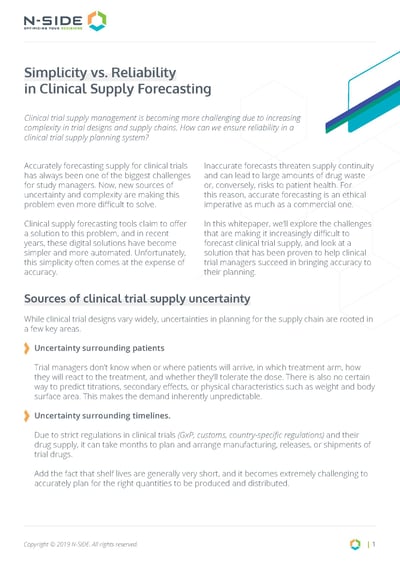Explained:
Forecasting and Optimization in Clinical Trials
Growing challenges related to clinical trial management have renewed interest in forecasting and optimization solutions.
Many pharmaceutical companies and contract research organizations (CROs) are examining their existing forecasting and optimization processes and searching for more effective solutions. Meanwhile, advanced analytics technologies including AI and machine learning are making forecasting and optimization more accurate and useful.
Here, we’ll explain the current clinical trial forecasting and optimization landscape, as well as the tools and solutions that are transforming it.

Table of contents
Key clinical trial forecasting and optimization challenges
Here are three challenges driving the search for better forecasting and optimization solutions:
Globalization
Trials are increasingly being conducted across many countries simultaneously. Each country has its own currencies, tax structures, regulations, and logistical complications that make forecasting and optimization more complicated.
Trial design complexity
Clinical trial protocols are becoming more complex in order to produce faster, more accurate results and target rarer diseases. Enrollment criteria, endpoints, dosing protocols, monitoring, and other factors are all more complex than ever before.
IMP complexity
Companies are investigating more advanced pharmaceuticals like biologics — which are more expensive, more difficult to produce, and have a limited shelf life compared to traditional drugs. It’s also more difficult to source comparators for these drugs.
Forecasting clinical trials
Clinical trials are getting more expensive, more complex, more global, and more heavily regulated. This puts pressure on clinical trial managers to be able to more accurately forecast all aspects of their trials, from enrollment to outcomes.
It’s impossible to create an accurate trial plan without accurate forecasts, and disruptions inevitably occur down the line as a result. Until adjustments are made and issues are ironed out, the trial sponsors lose money, and potentially life-changing medical products take longer to get to market.
Comprehensive, accurate forecasting allows for better budgeting and planning and keeps these potential disruptions to a minimum.
Did you know?
Only about 20% of pharma companies report a high level of confidence in their forecasts.
Source
Here are four main categories of forecasting that pharma companies and CROs should prioritize:
Supply and demand forecasting
Without being able to accurately determine supply and demand for IMP and comparators, supply managers need to build high amounts of drug overage into their trial plans. This leads to high costs, drug waste, and extended trial timelines.
Clinical supply forecasting attempts to model demand variables like recruitment, titrations, drug expiration, etc. in an effort to more accurately predict supply needs.
Unfortunately, most forecasting solutions aren’t accurate enough to significantly reduce overage while still avoiding risk of a drug stock-out. Risk-based clinical supply optimization is becoming the preferred alternative to forecasting in this space.
Cost and budget forecasting
As trials get more expensive and more complex, the acceptable margin of error for trial cost forecasts decreases. An inaccurate forecast can lead to overestimating the budget and therefore increasing waste, or underestimating the budget and taking unnecessary risks.
Sponsors and CROs are seeking more accurate clinical trial budgeting and forecasting tools that can predict recruitment, demand, sourcing challenges, and other factors and their impacts on costs well before a trial begins.
Recruitment and enrollment forecasting
Unexpected enrollment challenges can have a huge impact on trial costs and timelines.
Enroll too few patients, or enroll them too slowly, and you might need to extend the timeline or open new sites. Enroll too many patients, or enroll them too quickly, and you might create a crunch on the supply chain.
Clinical trial enrollment forecasting is key for keeping timelines and budgets under control. Luckily, new tools are making enrollment forecasts more accurate.
Trial outcome forecasting
With trials becoming more expensive, there is a growing desire among sponsors to be able to allocate resources toward trials with a higher chance of success.
To this end, some researchers are exploring using machine learning to predict trial outcomes before the trial even begins, using large sets of previous trial data.
How does clinical trial forecasting work?
Depending on the specific requirements of the trial, forecasting can be accomplished using any combination of manual effort (i.e. spreadsheets), third-party consultants, and software solutions.
More recently, specialized software providers that offer advanced analytics solutions have been gaining traction in the industry. These providers use technologies like advanced statistical modeling, Monte Carlo simulations, artificial intelligence, and machine learning to produce more accurate forecasts in more useful formats.
Historically, there has been some resistance to leveraging technologies like AI and machine learning in clinical trials.
This was largely due to the relative newness of the technology and uncertainty about how it would perform; clinical trials are expensive and tightly regulated, so many companies were initially reluctant to take on another perceived risk.
However, within the past few years, AI and machine learning have been proven effective as forecasting and optimization tools.
Additionally, the nature of machine learning means it becomes increasingly accurate over time — the more trials forecasted and optimized using this technology, the better it becomes. Experts believe it will be increasingly vital in clinical trials in the years to come.
BENEFITS OF ACCURATE FORECASTING
Optimizing clinical trials
Clinical trial optimization refers to the improvements of trial design, management, and/or processes both before and after a trial has begun. In many cases, the same technologies that enable improved forecasting — AI, machine learning, and advanced analytics — also enable improved optimization.
Here are five key types of clinical trial optimization you should know about:
Protocol design optimization
If the protocol design is not properly optimized to account for supply variables, it may be necessary to amend the protocol mid-trial. This is expensive and risky, especially in later-stage trials. The sooner protocol issues are identified, the better.
Using advanced analytics solutions, models can be used to anticipate issues by simulating the trial protocol before the study begins. Protocol components to test and optimize include:
- Country selection
- Visit schedule
- Kit design
- Titration scheme
- Screening period
Data from these simulations can then be used to optimize the protocol and make it more supply-friendly.
Recruitment and enrollment optimization
The recruitment process generates valuable data that can be used to optimize and hit recruitment goals ahead of schedule.
Software solutions enable enrollment optimization by analyzing data and flagging issues like roadblocks in the trial protocol or too-strict exclusion criteria. Using this data allows trial managers to identify ideal country and site selections and create an informed recruitment strategy.
Risk-based clinical trial supply optimization
Using advanced analytics software, trial program managers can input a number of factors (e.g. depot shipment, sourcing, packaging, IRT configuration) in order to assess uncertainty and mitigate the risk of missed dispensing while minimizing required overage. This risk-based optimization approach to trial supply management prevents under- or oversupply throughout the duration of the trial.
Clinical trial manufacturing optimization
Using advanced analytics, trial program managers can enhance their understanding of the impacts of key variables on the clinical trial supply chain. These variables include:
- Outsourcing vs. in-house manufacturing
- Vendor selection
- Lot sizing
- Stability plans and related expiry date extensions
- Regulatory constraints
- Current inventories
- Production, storage, and distribution timelines
- Allocation to clinical trials
Models based on these variables can be used to optimize the clinical trial supply chain on an ongoing basis and achieve reduced waste, increased agility, and reduced trial timelines, while ensuring 100% patient service level.
Comparator sourcing optimization
As clinical trials investigate more advanced pharmaceuticals, more complex comparators are also required.
In order to adequately cover risk, sponsors are under pressure to procure more comparator. Because comparator supply for complex drugs is often extremely limited, this can lead to blown budgets and extended trial timelines.
However, by optimizing the amount of comparator needed, clinical trial sourcing constraints can often be mitigated.
Thanks to advanced analytics, trial managers can calculate comparator overage as an output to reduce the risk of over- or undersupply.
The future of forecasting and optimization
Clinical trials are more complex than ever before. Pharma companies and CROs need access to software solutions that offer maximum visibility and control for even the most complex protocols.
The N-SIDE Suite, for example, is a SaaS platform that supports any clinical program, regardless of size or complexity. It uses advanced algorithms and cutting-edge analytics to provide risk-based optimization recommendations throughout the trial lifecycle, resulting in significant cost savings.
-1.png)
About N-SIDE
N-SIDE, an innovative software consulting company, has been an active player in clinical trial supply chain management for more than 20 years.
Using cloud-based, cutting-edge technologies, our solutions optimize the entire clinical trial supply chain management process from planning and production through to protocol design and delivery of supplies.
The N-SIDE Suite enables ambitious clinical plans through an optimal supply chain. Connecting strategic vision, operational implementation, and real-world events, the N-SIDE Suite empowers the pharmaceutical and biotech industries to reduce costs and drug waste, all while ensuring proactive risk management.




